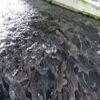Anise leaves, although not as commonly used as anise seeds, are also valued for their flavor and aroma. The botanical name for anise is Pimpinella anisum, and it belongs to the Apiaceae family. Anise leaves come from the same plant as anise seeds, which is native to the eastern Mediterranean region and Southwest Asia.
The leaves of the anise plant are delicate, feathery, and bright green in color, similar in appearance to other plants in the Apiaceae family, such as parsley and dill. While anise seeds are more frequently utilized in cooking and herbal medicine, anise leaves can also be used to add a subtle licorice-like flavor to dishes.
In culinary applications, anise leaves can be chopped finely and used as a garnish or added to salads, soups, stews, and sauces to impart their unique flavor. They can also be used to infuse liquids such as teas, broths, or syrups with a hint of anise essence.
Medicinally, anise leaves possess similar properties to anise seeds, including being carminative, antispasmodic, and expectorant. Therefore, they can be used in herbal preparations to aid digestion, relieve gastrointestinal discomfort, and alleviate coughs and respiratory congestion.
While not as commonly found in grocery stores as anise seeds, anise leaves can sometimes be obtained fresh from specialty markets or grown at home in herb gardens. Overall, anise leaves offer a fresh and aromatic addition to culinary dishes and herbal remedies, contributing their distinct flavor and potential health benefits.
The Economic Importance and Uses of Anise Leaves

1. Culinary Uses: Anise leaves are commonly used in culinary applications for their distinct flavor and aroma. They are often added to dishes such as salads, soups, and sauces to impart a subtle licorice-like taste.
2. Herbal Teas: Anise leaves are a popular ingredient in herbal teas due to their soothing properties and pleasant flavor. They can be brewed alone or combined with other herbs such as peppermint or chamomile for a refreshing and aromatic beverage.
3. Medicinal Purposes: In traditional medicine, anise leaves are used for their various health benefits. They are believed to aid digestion, alleviate symptoms of coughs and colds, and promote relaxation.
4. Flavoring Agent: Anise leaves are used as a natural flavoring agent in a variety of food and beverage products. They add a subtle sweetness and complexity to dishes such as desserts, beverages, and baked goods.
5. Aromatherapy: The essential oil extracted from anise leaves is valued in aromatherapy for its calming and soothing properties. It is often used in diffusers or added to massage oils to promote relaxation and reduce stress.
6. Culinary Garnish: Anise leaves can be used as a decorative garnish for food and beverages. Their vibrant green color and delicate texture add visual appeal to dishes, making them more appealing to consumers.
7. Digestive Aid: Anise leaves are known for their carminative properties, which can help alleviate gas, bloating, and indigestion. They are often consumed after meals to aid in digestion and promote gastrointestinal health.
8. Beverage Flavoring: Anise leaves are used to flavor a variety of beverages, including liqueurs, cocktails, and herbal infusions. Their unique taste adds depth and character to drinks, enhancing the overall drinking experience.
9. Potpourri Ingredient: Dried anise leaves are sometimes used in potpourri blends for their aromatic fragrance. They add a subtle sweet scent to potpourri mixtures, creating a pleasant aroma for the home.
10. Culinary Experimentation: Chefs and home cooks enjoy experimenting with anise leaves in their recipes. Their distinct flavor profile can add an unexpected twist to familiar dishes, inspiring culinary creativity.
11. Natural Insect Repellent: Anise leaves contain compounds that are known to repel insects, making them useful for pest control purposes. They can be placed in sachets or scattered around areas prone to infestation to deter bugs.
12. Cosmetic Applications: Anise leaves are used in some cosmetic products for their fragrance and aromatic properties. They add a subtle scent and may also have skin-soothing benefits.
13. Cultural Significance: In certain cultures, anise leaves hold cultural significance and are used in traditional rituals and ceremonies. They may be included as an offering or used in spiritual practices to invoke positive energy and blessings.
14. Culinary Tradition: Anise leaves are a staple ingredient in certain culinary traditions, particularly in cuisines where licorice-like flavors are appreciated. They are often used in traditional dishes and recipes passed down through generations.
15. Flavor Infusion: Anise leaves can be used to infuse flavor into various culinary creations. For example, they can be steeped in syrup or infused into cream to add a subtle anise flavor to desserts and confections.
16. Botanical Interest: Anise leaves are of botanical interest due to their unique appearance and fragrance. Botanists and horticulturists may study their morphology and cultivation techniques for research or educational purposes.
17. Culinary Tradition: Anise leaves are a staple ingredient in certain culinary traditions, particularly in cuisines where licorice-like flavors are appreciated. They are often used in traditional dishes and recipes passed down through generations.
Read Also: Ragamuffin Cat Breed Description and Complete Care Guide
The Products and By-products That Can Be Derived From Anise Leaves

1. Essential Oil: Anise leaves can be steam distilled to extract their essential oil, which is used in aromatherapy, perfumery, and cosmetic products. The oil has a sweet, spicy aroma and is believed to have calming and digestive properties.
2. Herbal Tea: Anise leaves are commonly used to make herbal teas that are consumed for their soothing and digestive benefits. The dried leaves are steeped in hot water to release their flavor and aroma, resulting in a fragrant and flavorful beverage.
3. Flavor Extract: Anise leaves are used to create flavor extracts that are added to food and beverage products to enhance their taste and aroma. The extract is typically made by soaking the dried leaves in alcohol or glycerin to extract their essential oils.
4. Culinary Ingredient: Anise leaves are used as a culinary ingredient in various dishes and recipes to add a subtle licorice-like flavor. They can be used fresh or dried, depending on the desired intensity of flavor.
5. Herbal Remedy: Anise leaves are used in traditional herbal remedies to treat a variety of ailments, including digestive issues, respiratory problems, and menstrual cramps. They are often brewed into teas or tinctures for medicinal purposes.
6. Incense: Anise leaves can be burned as incense for their aromatic fragrance. They are often used in religious or spiritual ceremonies to create a calming and uplifting atmosphere.
7. Animal Feed Additive: Anise leaves are sometimes added to animal feed as a flavoring agent to improve palatability. They can be mixed with other herbs and botanicals to create a nutritious and flavorful diet for livestock and pets.
8. Insect Repellent: Anise leaves contain compounds that are known to repel insects, making them useful for pest control purposes. They can be placed in sachets or scattered around areas prone to infestation to deter moths and other pests.
9. Cosmetic Ingredient: Anise leaves are used in cosmetic products such as soaps, lotions, and perfumes for their fragrance and aromatic properties. They add a subtle scent and may also have skin-soothing benefits.
10. Dietary Supplement: Anise leaves are sometimes consumed as a dietary supplement for their potential health benefits and medicinal properties. They may be taken in capsule or tincture form to support digestive health or relieve symptoms of coughs and colds.
Read Also: Moringa Fruits: Economic Importance, Uses, and By-Products
Frequently Asked Questions (FAQ’s) About Anise Leaves

1. What are anise leaves?
Anise leaves are the green, leafy part of the anise plant (Pimpinella anisum). They have a distinct flavor and aroma and are commonly used in culinary and medicinal applications.
2. How are anise leaves used in cooking?
Anise leaves can be used in a variety of culinary applications, including salads, soups, stews, sauces, and baked goods. They add a subtle licorice-like flavor and aroma to dishes.
3. Are anise leaves edible?
Yes, anise leaves are edible and can be consumed raw or cooked. They are often used as a flavoring agent in culinary recipes.
4. Do anise leaves have any health benefits?
Anise leaves are believed to have digestive and medicinal properties that may offer some health benefits. They are often used in traditional herbal medicine for their potential therapeutic effects.
5. Can anise leaves be used in herbal teas?
Yes, anise leaves are commonly used to make herbal teas that are consumed for their soothing and digestive properties. The dried leaves are steeped in hot water to release their flavor and aroma.
6. How should anise leaves be stored?
Anise leaves should be stored in the refrigerator in a sealed plastic bag or container to maintain freshness. They can also be dried and stored in an airtight container for longer-term storage.
7. Are anise leaves and anise seeds the same thing?
No, anise leaves are the green, leafy part of the anise plant, while anise seeds are the small seeds produced by the plant. They have different flavors and culinary uses.
8. Can anise leaves be used in aromatherapy?
Yes, anise leaves are used in aromatherapy for their calming and soothing properties. The essential oil extracted from the leaves is often used in diffusers or massage oils to promote relaxation and reduce stress.
9. Are anise leaves safe for pets?
While anise leaves are generally safe for human consumption, they may be toxic to pets in large quantities. It’s best to consult with a veterinarian before giving anise leaves or products containing anise to pets.
10. Where can I purchase anise leaves?
Anise leaves may be available at specialty grocery stores, farmers’ markets, or online retailers that sell fresh herbs and spices. They are typically sold in bunches or pre-packaged containers and can be used in a variety of culinary and medicinal applications.
Read Also: Interesting Facts About Giraffe





